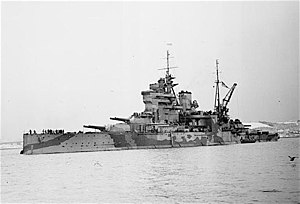 Queen Elizabeth in the Firth of Forth during the Second World War
| |
| History | |
|---|---|
| Name | Queen Elizabeth |
| Namesake | Elizabeth I |
| Builder | HM Dockyard, Portsmouth |
| Cost | £3,014,103 |
| Laid down | 21 October 1912 |
| Launched | 16 October 1913 |
| Completed | January 1914 |
| Commissioned | 22 December 1914 |
| Decommissioned | 1948 |
| Stricken | 7 July 1948 |
| Identification | Pennant number: 10 (1914); 97 (Jan 18); 00 (Apr 18)[1] |
| Motto | Semper Eadem ("Always the Same") |
| Fate | Scrapped, 1948 |
| Badge |  |
| General characteristics (as built) | |
| Class and type | Queen Elizabeth-class battleship |
| Displacement | |
| Length | 639 ft 9 in (195 m) |
| Beam | 90 ft 7 in (27.6 m) |
| Draught | 33 ft (10.1 m) |
| Installed power |
|
| Propulsion | 4 shafts; 2 steam turbine sets |
| Speed | 24 knots (44 km/h; 28 mph) |
| Range | 5,000 nmi (9,260 km; 5,750 mi) at 12 knots (22 km/h; 14 mph) |
| Complement | 1,262 (1920, as a flagship) |
| Armament |
|
| Armour |
|
HMS Queen Elizabeth was the lead ship of her class of five dreadnought battleships built for the Royal Navy in the early 1910s, and was often used as a flagship. She served in the First World War as part of the Grand Fleet, and participated in the inconclusive action of 19 August 1916. Her service during the war generally consisted of routine patrols and training in the North Sea. She and the other super-dreadnought battleships were the first of their type to be powered by oil instead of coal. Queen Elizabeth later served in several theatres during the Second World War, and was scrapped in 1948.
- ^ {{cite book |last1=Colledge |first1=J J |title=British Warships 1914–1919 |date=1972 |publisher=Ian Allan |location=Shepperton |page=34}